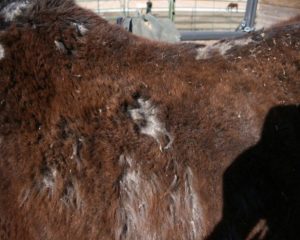The typical wet and humid weather of Louisiana are perfect conditions to increase the risk for your horse to contract the skin disease commonly known as “rain rot.” Rain rot or rain scald (also known as dermatophilosis) is commonly mistaken for a fungal disease, but is actually caused by a bacterial infection. The bacterium Dermatophilus congolensis, which causes the dry crusty lesions, lives dormant within the horse’s skin until the skin is damaged. Rain soaked skin, or skin that is broken, irritated, or damaged by insect bites or trauma is more likely to develop the condition. Heavy winter coats allow excess moisture to stay in contact with the skin causing an anaerobic (lack of oxygen) condition facilitating bacterial growth.
Diagnosis is typically done by visual conformation. Horses with winter coats will develop raised matted tufts of hair along their neck, withers, back, croup, and hindquarters. If not cared for the lesions will continue to grow and combine, creating scabs with yellow-green or gray colored pus underneath them.
The most important step in treating rain rot is to remove the crusty scab like lesions and expose the damaged skin to oxygen. This is usually done by bathing the affected area of skin with some type of antimicrobial shampoo (Betadine, Cholorhexadine, etc) and gently removing the lesions with a brush or curry comb. In more severe cases, additional layers of skin may be infected and will require systemic antibiotic treatment.
Rain rot is extremely contagious. Practicing good hygiene and biosecurity techniques are important to prevent the spread of this infection. Listed below are a few techniques that will help reduce the spread of Rain Rot:
- Groom daily with clean brushes
- Isolate infected horses
- Clean contaminated equipment before using on another animal
- Use an insect spray to reduce skin trauma
- Avoid sharing grooming kits
- Reduce environmental factors when possible (constant wet/humid conditions)
Mild cases of rain rot will usually heal on their own; however it is important to treat all cases to prevent the lesions from spreading and interfering with daily use. If you suspect your horse has a case of rain rot and antimicrobial treatment is ineffective, contact your veterinarian.







I have found using Apple Cider Vinegar Not Diluted But Poured Onto A Sponge and just hold on the areas of the equine that has rain rot and saturate the area. When doing this being called out to use on other’s horses some may hate the smell of the Apple Cider Vinegar to where I had horses trying to eat the sponge because they enjoyed it! TRY to do this twice a day!! I have found that majority of horses with all 4 legs, face, ears, neck cleared up 100% in 2 weeks. This is a very reasonable cost efficient way to remove “dew Poisoning” , “Rain Rot”, also other lesions on the body.